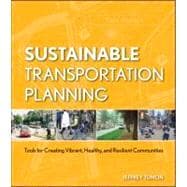
Note: Supplemental materials are not guaranteed with Rental or Used book purchases.
Purchase Benefits
What is included with this book?
Jeffrey Tumlin is an owner and sustainability practice leader of Nelson\Nygaard Consulting Associates, a San Francisco–based transportation planning and engineering firm that focuses on sustainable mobility. Over the past nineteen years, he has led station-area, downtown, citywide, and campus plans, and he has delivered various lectures and classes in twenty U.S. states and five other countries. His major development projects have succeeded in reducing their traffic and CO2 emissions by as much as 40% and have accommodated many millions of square feet of growth with no net increase in motor vehicle traffic. These projects have won awards from the General Services Administration, American Planning Association, American Society of Landscape Architects, Congress for the New Urbanism, and Urban Land Institute.
| Acknowledgments | p. vii |
| Foreword | p. ix |
| Introduction | p. 1 |
| Why Transportation? | p. 2 |
| The Big Picture: Mobility vs. Accessibility | p. 4 |
| Structure of This Book | p. 5 |
| Sustainable Transportation | p. 7 |
| What Is Sustainability? | p. 7 |
| Transportation and Public Health | p. 23 |
| The Human Body | p. 23 |
| Does This McMansion Make Me Look Fat? | p. 26 |
| Danger, Will Robinson! | p. 27 |
| Anger, Will Robinson! | p. 28 |
| Health and Equity | p. 29 |
| Driving and Social Health | p. 31 |
| Transportation and Trust | p. 31 |
| Conclusions | p. 33 |
| The City of the Future | p. 35 |
| Yesterday's Tomorrowland | p. 35 |
| Imagining the Sustainable City of the Future | p. 37 |
| Streets | p. 45 |
| Conceptualizing Streets | p. 45 |
| Principles of Street Design | p. 48 |
| Pedestrians | p. 51 |
| Introduction | p. 51 |
| Pedestrian Planning Principles | p. 51 |
| Pedestrian Planning Tools | p. 56 |
| Pedestrian Design Tools | p. 60 |
| Measuring Pedestrian Success | p. 69 |
| Case Study: Marin County Safe Routes to Schools | p. 71 |
| Bicycles | p. 73 |
| Introduction | p. 73 |
| Why Invest in Cycling? | p. 73 |
| Increasing Cycling | p. 74 |
| Key Cycling Principles | p. 76 |
| Design So That Everyone Will Enjoy Biking | p. 81 |
| Measuring Bicycle Success | p. 101 |
| Further Information | p. 101 |
| Transit | p. 105 |
| Introduction | p. 105 |
| Transit Modes | p. 106 |
| Case Study: Los Angeles Metro Rapid | p. 114 |
| Case Study: Portland Streetcar | p. 116 |
| Case Study: San Diego Trolley | p. 117 |
| Design for Transit | p. 121 |
| Measuring Success | p. 134 |
| Case Study: Boulder, Colorado, Community Transit Network | p. 136 |
| Transit Planning Resources | p. 136 |
| Motor Vehicles | p. 139 |
| Introduction | p. 139 |
| Designing for Cars | p. 143 |
| Design Manuals That Build upon Context | p. 149 |
| Design Guidance | p. 151 |
| Modeling Traffi c | p. 166 |
| Freeways | p. 169 |
| Parking | p. 173 |
| Introduction | p. 173 |
| Parking Is Destiny | p. 173 |
| Parking Economics | p. 101 |
| 175 Parking Tools | p. 177 |
| Parking Management Principles | p. 181 |
| Top Ten Parking Management Strategies | p. 186 |
| Carsharing | p. 205 |
| Introduction | p. 205 |
| Types of Carsharing | p. 206 |
| Impacts | p. 207 |
| Where Carsharing Is Most Successful | p. 208 |
| Public Policies That Support Carsharing | p. 212 |
| Municipal Fleets | p. 215 |
| Jump-Starting a Program | p. 216 |
| Stations and Station Areas | p. 217 |
| Introduction | p. 217 |
| Multimodal Access | p. 219 |
| Case Study: WMATA's Orange Line | p. 232 |
| Station Components | p. 234 |
| Case Study: BART Station Replacement Parking | p. 236 |
| Transportation Demand Management | p. 241 |
| What Is Traffic Congestion and Why Does It Happen? | p. 241 |
| Planning for Reduced Traffic | p. 244 |
| Traffic Reduction: A How-To Guide | p. 249 |
| Measuring Success | p. 263 |
| Definitions | p. 263 |
| How Performance Measures Are Used | p. 264 |
| How Performance Measures Are Misused | p. 264 |
| Measuring Success for Multiple Modes | p. 270 |
| Using Performance Measures to Balance Modes | p. 270 |
| Citywide Transportation System Measurements | p. 277 |
| Evaluating Project Alternatives | p. 282 |
| Additional Resources | p. 285 |
| For More Information | p. 287 |
| Useful Online Resources | p. 287 |
| Required Reading | p. 288 |
| Useful Tools | p. 289 |
| Endnotes | p. 297 |
| Index | p. 303 |
| Table of Contents provided by Publisher. All Rights Reserved. |
The New copy of this book will include any supplemental materials advertised. Please check the title of the book to determine if it should include any access cards, study guides, lab manuals, CDs, etc.
The Used, Rental and eBook copies of this book are not guaranteed to include any supplemental materials. Typically, only the book itself is included. This is true even if the title states it includes any access cards, study guides, lab manuals, CDs, etc.